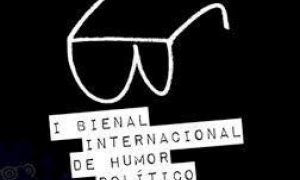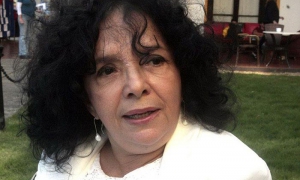Renowned Cuban artist Thelvia Marín has been awarded the Rafael Alberti Prize by the Havana International Poetry Festival. She was granted the prize along with Nicaraguan poet Claribel Alegría, who, at 90 years of age, was not able to attend the ceremony held at the Union of Cuba Writers and Artists’ Villena Hall. Thelvia Marín with one of her murals. Both Marín and Alegría have extended their creative work far beyond poetry, to sculpture, narrative, painting, essays and journalism. Upon receiving the award, the 92-year-old Cuban artist commented to the press, "Receiving a prize bearing the name of a poet like Alberti is, for me, a great honor and obliges me to continue writing and giving my best." In her 20’s, Thelvia Marín (Sancti Spíritus, 1922) received a scholarship to attend Havana’s San Alejandro Academy, where she studied painting with Ramón Loy and Leopoldo Romañach, developing a solid technical foundation. She graduated in two specialties, in 1947 and 1949. Her intellectual inquisitiveness led her to study philosophy, literature, pharmacy, psychology and journalism, as well. Her first book of poetry was A la naturaleza, and some 20 other volumes have followed, with Ego sum qui sum making a special impression. Published in 2009 in Tenerife, the 180-page book includes 250 photos of sculptures, 76 of paintings, 80 poems and two stories. A veritable catalogue of her artistic work. Monumento al desarme, el trabajo y la paz, in Costa Rica (Foto: GORY) In 2011, the Canary Islands Association of Cuba published Piel de sílabas - Antología poética 1957-2011. In 2006, Cuba’s Ciencias Sociales publishing house released Viaje al Sexto Sol, a novel-like essay (or essay-like novella) about indigenous Mesoamerican peoples. The intellectual Lisandro Otero writes in the prologue, "Only a rhapsody could capture the imaginative range, the wealth of fantasy and vastness of the arcane dreams of these innocent tenets, unclouded by any civilizing deformation." Earlier, in 1976, released was the testimonial novel Condenados: del presidio a la vida (Editorial Siglo XXI), with a prologue by historian Julio Le Riverend, who wrote, "Three years of sociological and historical research on the Isle of Pines, and its utilization as a prison, have led to this work…" José Martí (1989). Bronze, cement and a water mirror, on the Universidad para la Paz campus in Costa Rica. Her years as a cultural advisor in Germany produced her essay on the steamship Nordstrand, and its captain, Heinrich Julius Theodor Löwe. This was the ship which, in 1895, brought José Martí, General Máximo Gómez and their expedition to Cuba, to begin the "necessary war" for Cuba’s independence. But sculpture is, no doubt, Thelvia Marín’s great passion, in which her energy is sensed, her extensive body of work, vigorously innovative in terms of subject, shape, style, technique, format and material. Specialists, such as Nieves Leonard Pie in her book Thelvia Marín: las claves de su escultura, address the traditional, monumental outdoor works, of large and small format. Her work in this field is vast. Best known in Cuba, among these works, are her 1980 monumental tribute to General Serafín Sánchez, participant in Cuba’s three wars of independence, located in Sancti Spíritus; the one dedicated to Camilo Cienfuegos in Yaguajay, completed in 1987, within a landscape design by architect Pedro Pérez Argudín; and Lenin Hill, created in 1984 with architect Orestes del Castillo, located in the Havana municipality of Regla. Both the Serafín Sánchez Monument and Lenin Hill are officially designated National Monuments. José Martí (1983). Mármol fundido (relieve). Escuela de Ciencias Médicas, La Habana. Thelvia Marín’s monumental work includes the Tríptico de Maceo; Monumento a Panchito Gómez Toro; and the Monumento a Faustino Pérez, who was her companion in the underground struggle during the difficult decade of the 1950’s. Nieves Pie emphasizes in her book that Marín’s works included poetic inspiration to complement the visual art. She wrote the poem "Raíces" dedicated to Maceo; "Pasos" for the Panchito Gómez piece; and for the monument in Yaguajay, the poem "Camilo." Her commitment to José Martí’s ideas was expressed in her eight busts and three heads of Martí; in her Havana murals; and her monument at the Universidad para la Paz, in Costa Rica (UPAZ). This last piece at the institution of higher learning was sponsored by the UN and is located within the Monument to Work, Disarmament and Peace, 21 meters in length and 18 high. Marín was the daughter of a woman from the Canary Islands, and the artist erected three monuments there: one to workers, in Agüime; one to immigrants, in Telde; and a third to Leonor Pérez, Martí’s mother, in her native Tenerife. Sculpture on Lenin Hill in the Havana municipality of Regla. Photo: Gilberto Rabassa. In Luanda, Angola, is located a sculpted head by Marín, depicting Aquilino Amézaga, the slave Serafín Sánchez taught to read, who can also be seen in the Sancti Spiritus monument to Sánchez. Ecuador’s capital, Quito, honored her as a Distinguished Guest, recognizing the artist for her creation of Indio Hatuey, which stands in the city’s Indoamérica Plaza. Her park sculpture, sprinkled across the island, includes a long list of works such as Bailarín, Los Íremes, La Fuente de Yemayá, Los delfines, Las Gaviotas, Estrella de mar, Güije, Para Leda en azul, Fuente de la Herminia, Dujo… Marín’s works of small, medium and large format include Mujer, Maternidad, Alicia Alonso, Platero y yo, Mujer de agua dulce, Las manos… A prize does not define such a vast body of work, but since it bears the name of Rafael Alberti, we are grateful. It has allowed us the opportunity to recall, and celebrate, an artist of great intellectual stature, Thelvia Marin.

HAVANA, DECEMBER 9, 2025
OFFICIAL VOICE OF THE COMMUNIST
PARTY OF CUBA CENTRAL COMMITTEE
Culture

In Cuba, I International Biennial of Political Humor
The 1st International Biennial of Political Humor will arrive in the Cuban capital on June 14 and will be held in several venues until June 28
Recommended
PRESS DIRECTORY:
PUBLICATIONS ONLINE
Juventud Rebelde | Trabajadores. | Cubadebate | AIN | Prensa Latina | Opciones | CubaSi | Cubahora | Cubaperiodistas
MAGAZINES
Bohemia | Cuba Socialista | Mujeres | Tricontinental | La Jiribilla | Alma Mater | Caimán Barbudo | Juventud Técnica | Pionero
TV & RADIO
TV Cubana | Radio Cubana | Radio Habana Cuba | Radio Progreso | Radio Rebelde | Radio Reloj | Radio Taino | Radio Musical Nacional




